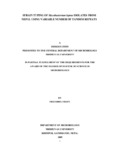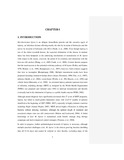Please use this identifier to cite or link to this item:
https://elibrary.tucl.edu.np/handle/123456789/591| Title: | Strain Typing of mycobacterium Leprae isolates From nepal Using Variable Number of Tandem Repeats |
| Authors: | Thapa, Pratibha |
| Keywords: | Molecular epidemiology;Minisatellite;polymorphism |
| Issue Date: | 2009 |
| Publisher: | Department of Microbiology |
| Institute Name: | Central Department of Microbiology |
| Level: | Masters |
| Abstract: | Poor understanding of leprosy transmission has generated the need for molecular toolsfor the strain differentiation of M. leprae isolates. Tandem repeats, namelymicrosatellites and minisatellites also known as variable number of tandem repeats(VNTRs) were applied to assess strain variability amongM. leprae isolates fromNepal to potentially identify epidemiological patterns. VNTR PCR of DNA extractedfrom 52 elliptical or punch biopsy samples by freeze and boil method, was performedfor each six minisatellites (21-3, 27-5, 23-3, 12-5, 18-8 and 6-7) and sixmicrosatellites (GGT5, GTA9, AT17, TA18, AC9 and AC8b) to find out the copynumbers of the repeats withinM. lepraegenome. The amplicons were analyzed byusing 8% polyacrylamide gel electrophoresis (PAGE) and band size ofPCR positivesamples was calculated using a web based programme ‘Computation of size ofDNAand Protein Fragments from their Electrophoretic Mobility’ and VNTR data analysiswas performed using Microsatellite tool kit. Locus 27-5 was the least polymorphicwith allelic diversity of 0.373; whereas locus AC 8b was found to be the mostpolymorphic with allelic diversity 0.908. Clustering of the samples identified 7different clusters in Nepal with no observable relation to geographical distribution,ethnic groupand sex. Comparison of VNTR pattern of Nepalese isolates with globaldata revealed a wide range of genotypes prevalent in Nepal. The study demonstratedthe suitability of minisatellites as a genetic marker for potential strain typing andmapping of short range transmission in Nepal. Microsatellite allele differences couldnot be dependably resolved using PAGE analyses and appeared too hypervariable forclustering within this size population study. In summary, the six member minisatellitePCR panel with PAGE analysis employed in this study has been shown to identifypotential strain clusters in Nepalese leprosy patient skin biopsy-derivedM. lepraesamples with important similarities as well as distinctive differences to reportedstrains from neighboring China and India. Key Words: Strain typing, Molecular epidemiology, Variable number of tandemrepeats, Minisatellite, Microsatellite, polymorphism. |
| URI: | http://elibrary.tucl.edu.np/handle/123456789/591 |
| Appears in Collections: | Microbiology |
Files in This Item:
| File | Description | Size | Format | |
|---|---|---|---|---|
| COVER.pdf | 35.29 kB | Adobe PDF |  View/Open | |
| CHAPTER.pdf | 566.63 kB | Adobe PDF |  View/Open |
Items in DSpace are protected by copyright, with all rights reserved, unless otherwise indicated.
